University of the Incarnate Word PMBA 6314 MIS Report
VerifiedAdded on 2023/01/20
|5
|1292
|83
Report
AI Summary
This report provides an overview of three key areas within Management Information Systems: Accounting Management Systems, Enterprise Application Integration (EAI), and Customer Relationship Management (CRM). The Accounting Management System section discusses its functionalities, integration with other systems, and its advantages over traditional accounting methods. The EAI section explains its evolution as a solution for integrating different applications, addressing the integration of data and business processes. The CRM section explores the importance of selecting the right CRM software, integrating people, processes, and technology for successful customer relationship management. The report is written in APA style, includes a cover and references page, and demonstrates the student's comprehension of the course material by synthesizing the subjects, and providing applied reaction concepts, such as how to apply the information to the workplace. The report is based on the readings from Chapters 7 and 8 of the textbook PMBA 6314 Manage/Information Technology Management Information Systems 10th Edition.
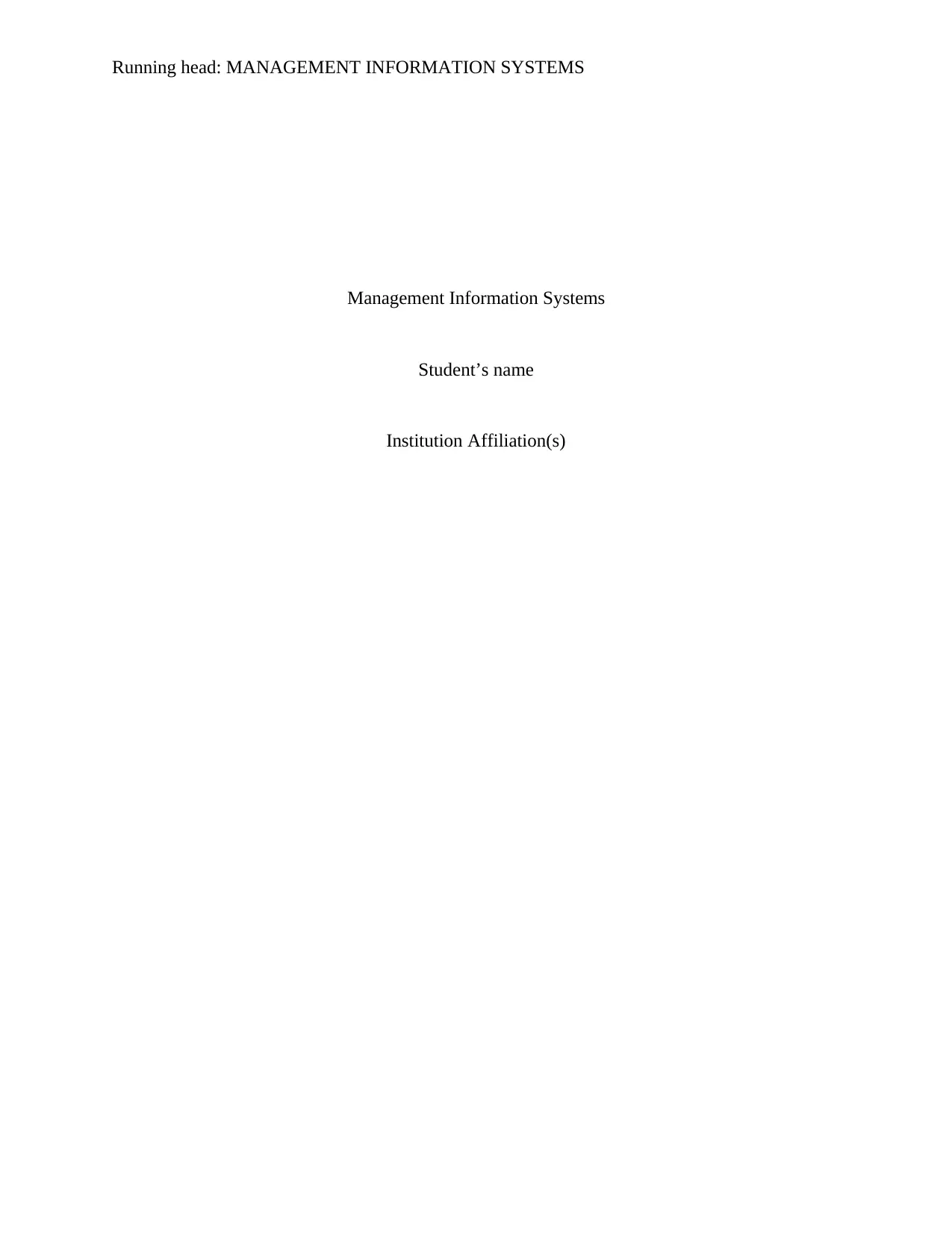
Running head: MANAGEMENT INFORMATION SYSTEMS
Management Information Systems
Student’s name
Institution Affiliation(s)
Management Information Systems
Student’s name
Institution Affiliation(s)
Paraphrase This Document
Need a fresh take? Get an instant paraphrase of this document with our AI Paraphraser
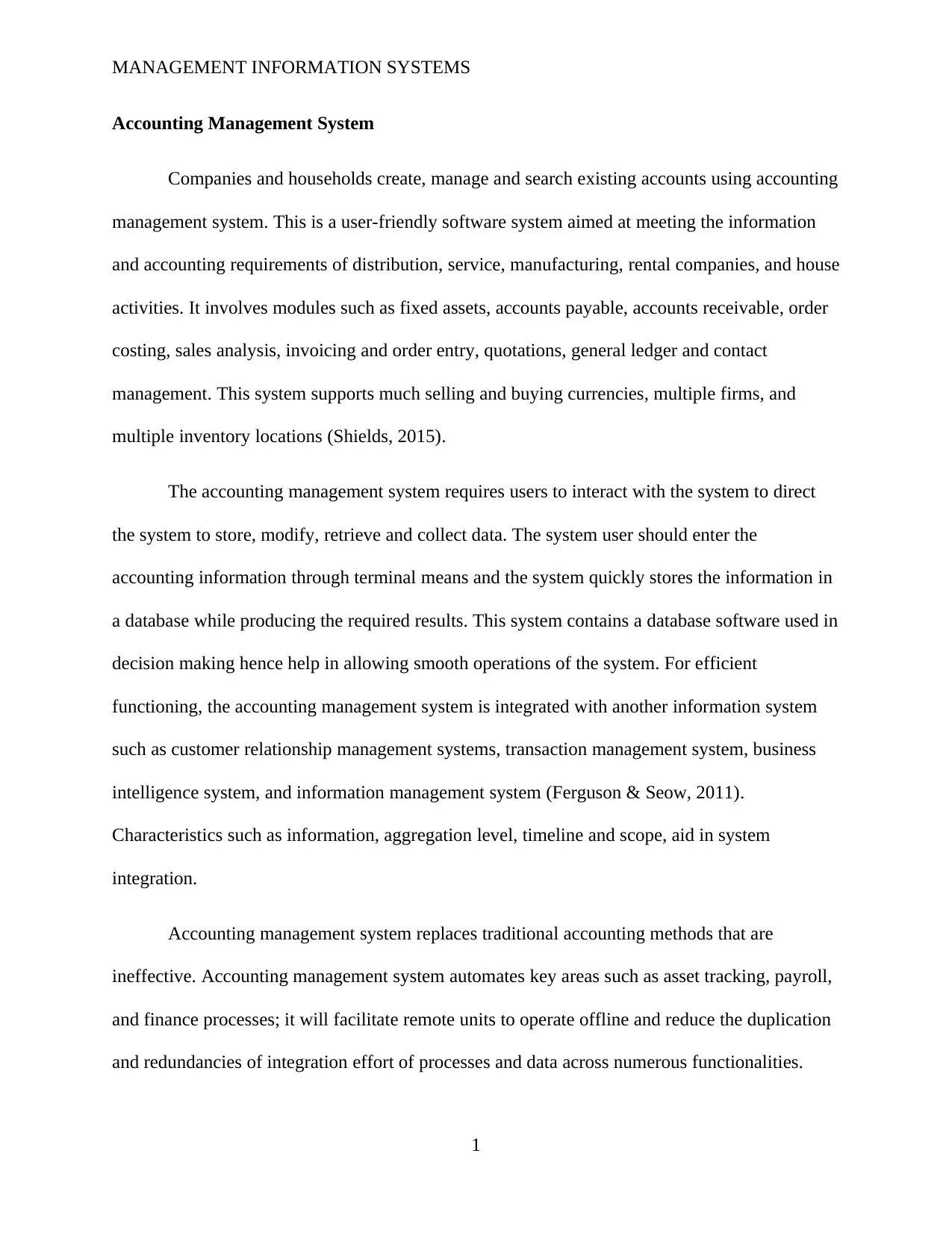
MANAGEMENT INFORMATION SYSTEMS
Accounting Management System
Companies and households create, manage and search existing accounts using accounting
management system. This is a user-friendly software system aimed at meeting the information
and accounting requirements of distribution, service, manufacturing, rental companies, and house
activities. It involves modules such as fixed assets, accounts payable, accounts receivable, order
costing, sales analysis, invoicing and order entry, quotations, general ledger and contact
management. This system supports much selling and buying currencies, multiple firms, and
multiple inventory locations (Shields, 2015).
The accounting management system requires users to interact with the system to direct
the system to store, modify, retrieve and collect data. The system user should enter the
accounting information through terminal means and the system quickly stores the information in
a database while producing the required results. This system contains a database software used in
decision making hence help in allowing smooth operations of the system. For efficient
functioning, the accounting management system is integrated with another information system
such as customer relationship management systems, transaction management system, business
intelligence system, and information management system (Ferguson & Seow, 2011).
Characteristics such as information, aggregation level, timeline and scope, aid in system
integration.
Accounting management system replaces traditional accounting methods that are
ineffective. Accounting management system automates key areas such as asset tracking, payroll,
and finance processes; it will facilitate remote units to operate offline and reduce the duplication
and redundancies of integration effort of processes and data across numerous functionalities.
1
Accounting Management System
Companies and households create, manage and search existing accounts using accounting
management system. This is a user-friendly software system aimed at meeting the information
and accounting requirements of distribution, service, manufacturing, rental companies, and house
activities. It involves modules such as fixed assets, accounts payable, accounts receivable, order
costing, sales analysis, invoicing and order entry, quotations, general ledger and contact
management. This system supports much selling and buying currencies, multiple firms, and
multiple inventory locations (Shields, 2015).
The accounting management system requires users to interact with the system to direct
the system to store, modify, retrieve and collect data. The system user should enter the
accounting information through terminal means and the system quickly stores the information in
a database while producing the required results. This system contains a database software used in
decision making hence help in allowing smooth operations of the system. For efficient
functioning, the accounting management system is integrated with another information system
such as customer relationship management systems, transaction management system, business
intelligence system, and information management system (Ferguson & Seow, 2011).
Characteristics such as information, aggregation level, timeline and scope, aid in system
integration.
Accounting management system replaces traditional accounting methods that are
ineffective. Accounting management system automates key areas such as asset tracking, payroll,
and finance processes; it will facilitate remote units to operate offline and reduce the duplication
and redundancies of integration effort of processes and data across numerous functionalities.
1
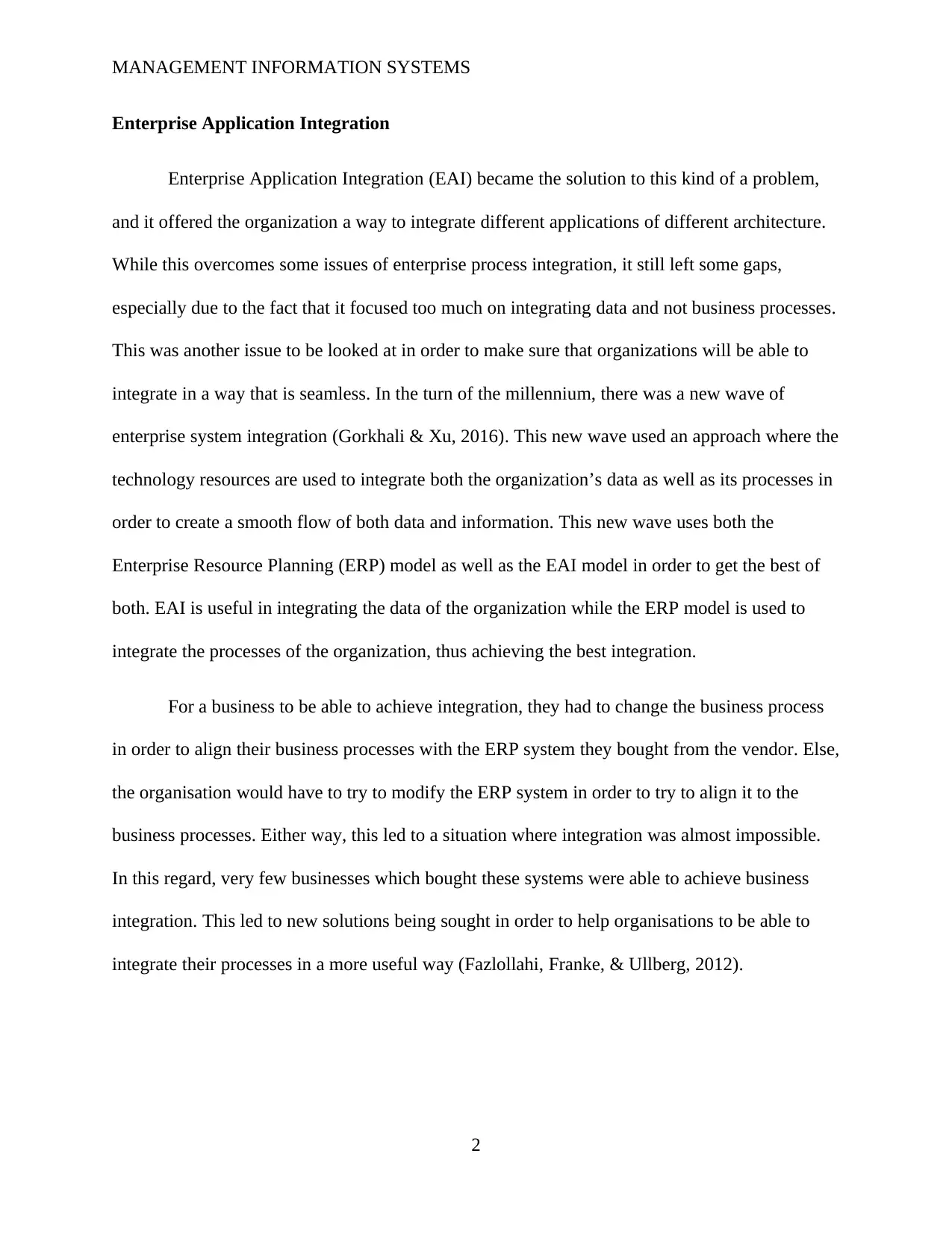
MANAGEMENT INFORMATION SYSTEMS
Enterprise Application Integration
Enterprise Application Integration (EAI) became the solution to this kind of a problem,
and it offered the organization a way to integrate different applications of different architecture.
While this overcomes some issues of enterprise process integration, it still left some gaps,
especially due to the fact that it focused too much on integrating data and not business processes.
This was another issue to be looked at in order to make sure that organizations will be able to
integrate in a way that is seamless. In the turn of the millennium, there was a new wave of
enterprise system integration (Gorkhali & Xu, 2016). This new wave used an approach where the
technology resources are used to integrate both the organization’s data as well as its processes in
order to create a smooth flow of both data and information. This new wave uses both the
Enterprise Resource Planning (ERP) model as well as the EAI model in order to get the best of
both. EAI is useful in integrating the data of the organization while the ERP model is used to
integrate the processes of the organization, thus achieving the best integration.
For a business to be able to achieve integration, they had to change the business process
in order to align their business processes with the ERP system they bought from the vendor. Else,
the organisation would have to try to modify the ERP system in order to try to align it to the
business processes. Either way, this led to a situation where integration was almost impossible.
In this regard, very few businesses which bought these systems were able to achieve business
integration. This led to new solutions being sought in order to help organisations to be able to
integrate their processes in a more useful way (Fazlollahi, Franke, & Ullberg, 2012).
2
Enterprise Application Integration
Enterprise Application Integration (EAI) became the solution to this kind of a problem,
and it offered the organization a way to integrate different applications of different architecture.
While this overcomes some issues of enterprise process integration, it still left some gaps,
especially due to the fact that it focused too much on integrating data and not business processes.
This was another issue to be looked at in order to make sure that organizations will be able to
integrate in a way that is seamless. In the turn of the millennium, there was a new wave of
enterprise system integration (Gorkhali & Xu, 2016). This new wave used an approach where the
technology resources are used to integrate both the organization’s data as well as its processes in
order to create a smooth flow of both data and information. This new wave uses both the
Enterprise Resource Planning (ERP) model as well as the EAI model in order to get the best of
both. EAI is useful in integrating the data of the organization while the ERP model is used to
integrate the processes of the organization, thus achieving the best integration.
For a business to be able to achieve integration, they had to change the business process
in order to align their business processes with the ERP system they bought from the vendor. Else,
the organisation would have to try to modify the ERP system in order to try to align it to the
business processes. Either way, this led to a situation where integration was almost impossible.
In this regard, very few businesses which bought these systems were able to achieve business
integration. This led to new solutions being sought in order to help organisations to be able to
integrate their processes in a more useful way (Fazlollahi, Franke, & Ullberg, 2012).
2
⊘ This is a preview!⊘
Do you want full access?
Subscribe today to unlock all pages.

Trusted by 1+ million students worldwide
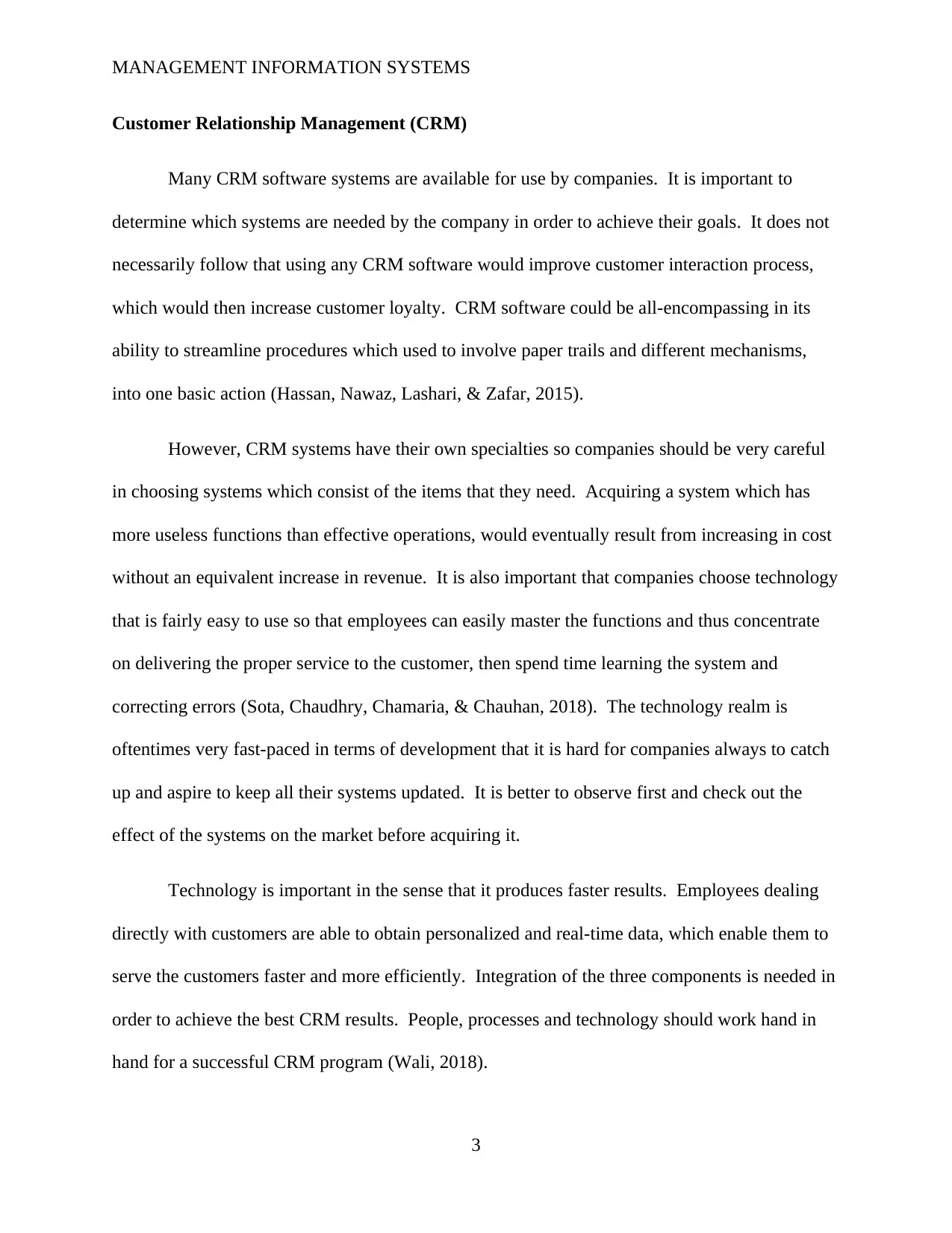
MANAGEMENT INFORMATION SYSTEMS
Customer Relationship Management (CRM)
Many CRM software systems are available for use by companies. It is important to
determine which systems are needed by the company in order to achieve their goals. It does not
necessarily follow that using any CRM software would improve customer interaction process,
which would then increase customer loyalty. CRM software could be all-encompassing in its
ability to streamline procedures which used to involve paper trails and different mechanisms,
into one basic action (Hassan, Nawaz, Lashari, & Zafar, 2015).
However, CRM systems have their own specialties so companies should be very careful
in choosing systems which consist of the items that they need. Acquiring a system which has
more useless functions than effective operations, would eventually result from increasing in cost
without an equivalent increase in revenue. It is also important that companies choose technology
that is fairly easy to use so that employees can easily master the functions and thus concentrate
on delivering the proper service to the customer, then spend time learning the system and
correcting errors (Sota, Chaudhry, Chamaria, & Chauhan, 2018). The technology realm is
oftentimes very fast-paced in terms of development that it is hard for companies always to catch
up and aspire to keep all their systems updated. It is better to observe first and check out the
effect of the systems on the market before acquiring it.
Technology is important in the sense that it produces faster results. Employees dealing
directly with customers are able to obtain personalized and real-time data, which enable them to
serve the customers faster and more efficiently. Integration of the three components is needed in
order to achieve the best CRM results. People, processes and technology should work hand in
hand for a successful CRM program (Wali, 2018).
3
Customer Relationship Management (CRM)
Many CRM software systems are available for use by companies. It is important to
determine which systems are needed by the company in order to achieve their goals. It does not
necessarily follow that using any CRM software would improve customer interaction process,
which would then increase customer loyalty. CRM software could be all-encompassing in its
ability to streamline procedures which used to involve paper trails and different mechanisms,
into one basic action (Hassan, Nawaz, Lashari, & Zafar, 2015).
However, CRM systems have their own specialties so companies should be very careful
in choosing systems which consist of the items that they need. Acquiring a system which has
more useless functions than effective operations, would eventually result from increasing in cost
without an equivalent increase in revenue. It is also important that companies choose technology
that is fairly easy to use so that employees can easily master the functions and thus concentrate
on delivering the proper service to the customer, then spend time learning the system and
correcting errors (Sota, Chaudhry, Chamaria, & Chauhan, 2018). The technology realm is
oftentimes very fast-paced in terms of development that it is hard for companies always to catch
up and aspire to keep all their systems updated. It is better to observe first and check out the
effect of the systems on the market before acquiring it.
Technology is important in the sense that it produces faster results. Employees dealing
directly with customers are able to obtain personalized and real-time data, which enable them to
serve the customers faster and more efficiently. Integration of the three components is needed in
order to achieve the best CRM results. People, processes and technology should work hand in
hand for a successful CRM program (Wali, 2018).
3
Paraphrase This Document
Need a fresh take? Get an instant paraphrase of this document with our AI Paraphraser
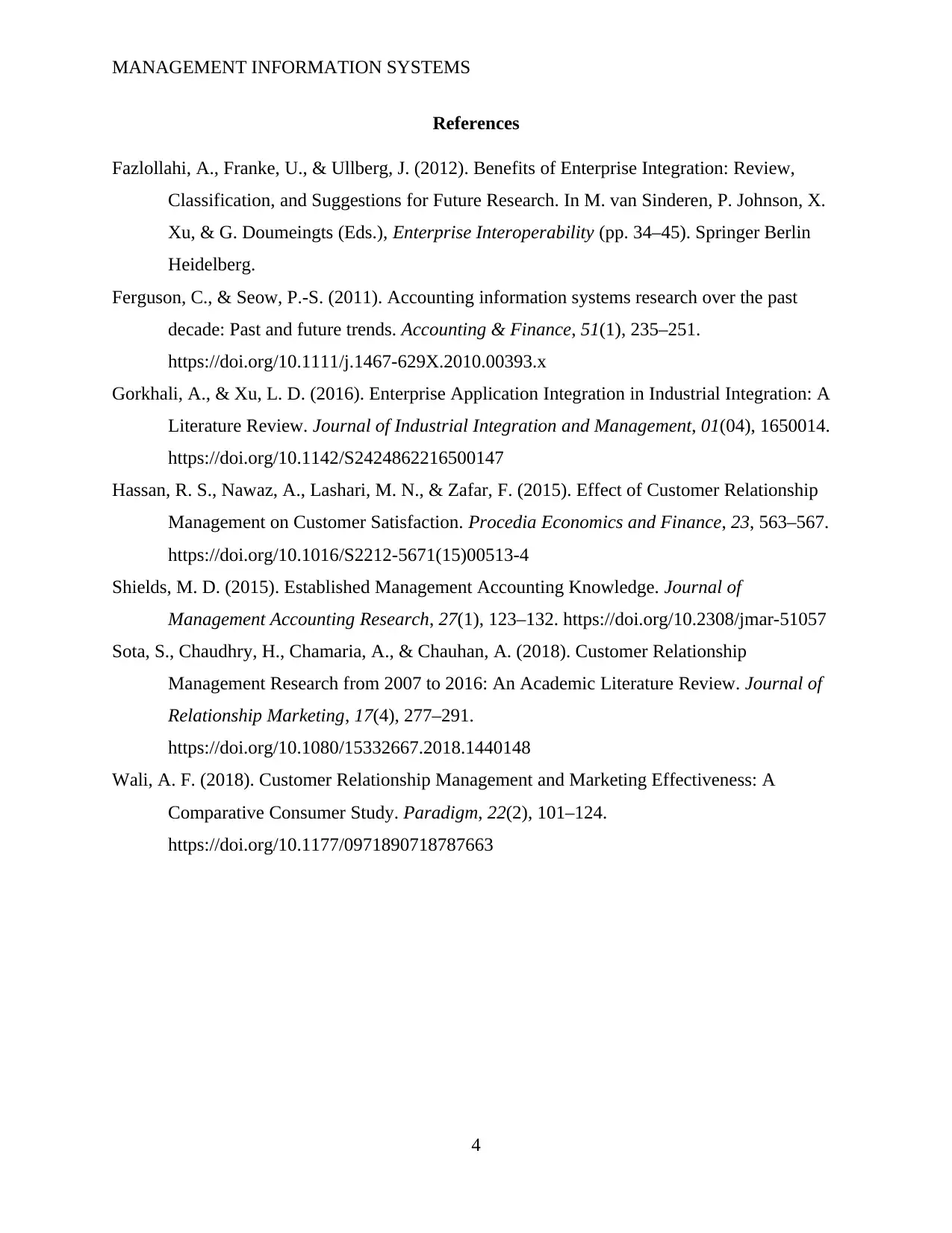
MANAGEMENT INFORMATION SYSTEMS
References
Fazlollahi, A., Franke, U., & Ullberg, J. (2012). Benefits of Enterprise Integration: Review,
Classification, and Suggestions for Future Research. In M. van Sinderen, P. Johnson, X.
Xu, & G. Doumeingts (Eds.), Enterprise Interoperability (pp. 34–45). Springer Berlin
Heidelberg.
Ferguson, C., & Seow, P.-S. (2011). Accounting information systems research over the past
decade: Past and future trends. Accounting & Finance, 51(1), 235–251.
https://doi.org/10.1111/j.1467-629X.2010.00393.x
Gorkhali, A., & Xu, L. D. (2016). Enterprise Application Integration in Industrial Integration: A
Literature Review. Journal of Industrial Integration and Management, 01(04), 1650014.
https://doi.org/10.1142/S2424862216500147
Hassan, R. S., Nawaz, A., Lashari, M. N., & Zafar, F. (2015). Effect of Customer Relationship
Management on Customer Satisfaction. Procedia Economics and Finance, 23, 563–567.
https://doi.org/10.1016/S2212-5671(15)00513-4
Shields, M. D. (2015). Established Management Accounting Knowledge. Journal of
Management Accounting Research, 27(1), 123–132. https://doi.org/10.2308/jmar-51057
Sota, S., Chaudhry, H., Chamaria, A., & Chauhan, A. (2018). Customer Relationship
Management Research from 2007 to 2016: An Academic Literature Review. Journal of
Relationship Marketing, 17(4), 277–291.
https://doi.org/10.1080/15332667.2018.1440148
Wali, A. F. (2018). Customer Relationship Management and Marketing Effectiveness: A
Comparative Consumer Study. Paradigm, 22(2), 101–124.
https://doi.org/10.1177/0971890718787663
4
References
Fazlollahi, A., Franke, U., & Ullberg, J. (2012). Benefits of Enterprise Integration: Review,
Classification, and Suggestions for Future Research. In M. van Sinderen, P. Johnson, X.
Xu, & G. Doumeingts (Eds.), Enterprise Interoperability (pp. 34–45). Springer Berlin
Heidelberg.
Ferguson, C., & Seow, P.-S. (2011). Accounting information systems research over the past
decade: Past and future trends. Accounting & Finance, 51(1), 235–251.
https://doi.org/10.1111/j.1467-629X.2010.00393.x
Gorkhali, A., & Xu, L. D. (2016). Enterprise Application Integration in Industrial Integration: A
Literature Review. Journal of Industrial Integration and Management, 01(04), 1650014.
https://doi.org/10.1142/S2424862216500147
Hassan, R. S., Nawaz, A., Lashari, M. N., & Zafar, F. (2015). Effect of Customer Relationship
Management on Customer Satisfaction. Procedia Economics and Finance, 23, 563–567.
https://doi.org/10.1016/S2212-5671(15)00513-4
Shields, M. D. (2015). Established Management Accounting Knowledge. Journal of
Management Accounting Research, 27(1), 123–132. https://doi.org/10.2308/jmar-51057
Sota, S., Chaudhry, H., Chamaria, A., & Chauhan, A. (2018). Customer Relationship
Management Research from 2007 to 2016: An Academic Literature Review. Journal of
Relationship Marketing, 17(4), 277–291.
https://doi.org/10.1080/15332667.2018.1440148
Wali, A. F. (2018). Customer Relationship Management and Marketing Effectiveness: A
Comparative Consumer Study. Paradigm, 22(2), 101–124.
https://doi.org/10.1177/0971890718787663
4
1 out of 5
Related Documents
Your All-in-One AI-Powered Toolkit for Academic Success.
+13062052269
info@desklib.com
Available 24*7 on WhatsApp / Email
![[object Object]](/_next/static/media/star-bottom.7253800d.svg)
Unlock your academic potential
Copyright © 2020–2025 A2Z Services. All Rights Reserved. Developed and managed by ZUCOL.




